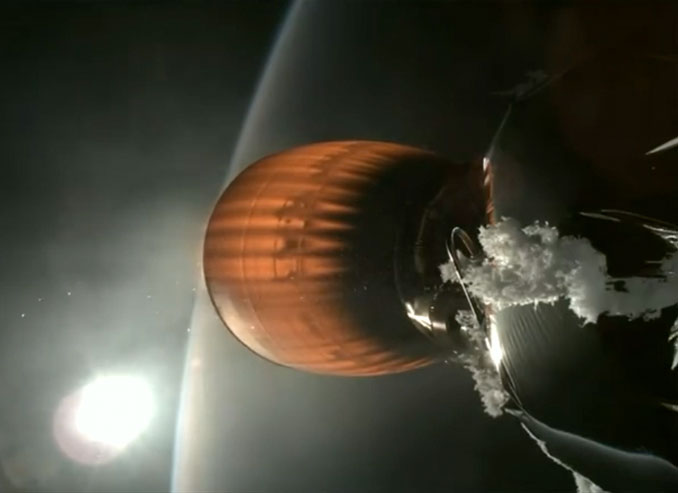
SpaceX suffered its first in-flight Falcon 9 rocket failure since 2015, sending 20 Starlink satellites into a dangerously low orbit. SpaceX founder Elon Musk said it was unclear whether the spacecraft could be saved using onboard ion thrusters.
SpaceX’s 70th orbital launch this year, dubbed Starlink 9-3, initially appeared to go smoothly after lifting off from Vandenberg Space Force Base Thursday night at 7:35 p.m. PDT (10:35 p.m. EDT, 02:35 UTC). But during the Falcon 9’s second stage burn, an unusual amount of ice was seen building up around the Merlin Vacuum engine in camera footage taken from the rocket.
About an hour after the satellite was deployed, Musk posted on his social media platform X: “Upper stage restart to raise perigee resulted in engine RUD [Rapid Unscheduled Disassembly] for reasons currently unknown. The team is reviewing the data tonight to determine the root cause.”
The second stage would burn for one second to circularize the orbit, launching 52 minutes and 20 seconds after launch.
As for the fate of the rocket’s payload, Musk added: “Starlink satellites have been deployed, but the perigee may be too low to raise the orbit. We’ll know more in a few hours.”
The batch of 20 Starlink satellites included 13 with the ability to communicate directly with mobile phones. SpaceX said it had successfully contacted five of the satellites and was attempting to raise their orbits. Jonathan McDowell, an astronomer at the Harvard-Smithsonian Center for Astrophysics, which maintains a database of spaceflight, predicted the satellites were likely in orbits measuring 295 by 138 kilometers. The intended deployment orbit was 296 by 286 kilometers.
“We are updating the satellite software to run the ion thrusters at their equivalent of warp 9,” Musk said in an update on social media. “Unlike a Star Trek episode, this probably won’t work, but it’s worth a try. The satellite thrusters need to get into orbit faster than atmospheric drag is pulling them down, or they’ll burn up.”
The last in-flight failure of a Falcon 9 rocket occurred on June 28, 2015, when a Dragon cargo resupply mission ended 139 seconds into the flight. Another Falcon 9 exploded on the launch pad at Cape Canaveral during fueling operations for a pre-flight static test fire on September 1, 2016, destroying an Israeli communications satellite and causing extensive damage to Space Launch Complex 40.

The first stage of the Falcon 9 booster for the Starlink 9-3 mission, tail number B1063 in the SpaceX fleet, flew for the 19th time. Previous launches include NASA’s Double Asteroid Redirection Test (DART) spacecraft, the Transporter-7 rideshare mission and 13 batches of Starlink satellites.
Just over eight minutes after launch, B1063 landed on the SpaceX drone ship ‘Of Course I Still Love You’. This was the 96th landing on OCISLY and the 329th booster landing to date.
